

(1) Thinking about God: Each chapter in this book reflects on images and ideas about God – aspects of the Divine Mystery that the Christian tradition may have forgotten or overlooked.
(2) Contextual theologies: The theologies rise out of the life experience of various peoples – Europeans and Asians, African-Americans, Latinos, and women. These theologies also arise from new insights from modern science, social sciences and humanities, as well as from Christian scripture and tradition.
(3) The Living God – The book’s title, Quest for the Living God, uses a Biblical phrase, the ‘Living God’ to describe the God who is “full of energy and spirit, alive with designs for liberation and healing, always approaching from the future to do something new. In addition, the term ‘living God’ evokes the realization that there is always more to divine Mystery than human beings can nail down.”
Reflecting on the reading:
As children and young people, most of us learned our ‘theology’ (although that word probably wasn’t used) from clergy and religion teachers, who passed on to us what the Scriptures and Christian tradition hold to be true. What would we have learned if our pastors and teachers had started not with the tradition but with questions:
How have you experienced the Holy in your own life?
What have your experiences taught you about God?
Ancient Story, New Chapter

NOTE: Elizabeth Johnson has chosen a descriptive subtitle for each section of her chapters. (You will also find these subtitles in the table of contents.) In the brief chapter summaries posted here, each subtitle introduces the main themes of the section.
(1) From the beginning: History shows that human beings are naturally religious; that is, the record shows that humans have always sought (and are still seeking) the transcendent dimension of life.
(2) Peoples of the Book: Jews, Christians and Muslims have shown, through their history and sacred texts, that their people have always sought to experience the Holy. The scriptures of all three traditions also describe a God who continually seeks for them.
(3) Why the search? The living God is beyond description, and thus can never be wholly captured in words, but the human search for God goes on because the human heart is insatiable – and constant change in human culture mean that our experiences of God are always mediated through new realities. Thus new attempts to articulate ideas about God are to be expected. Christianity is now living through a new chapter in this quest.
Gracious Mystery, Ever Greater, Ever Nearer
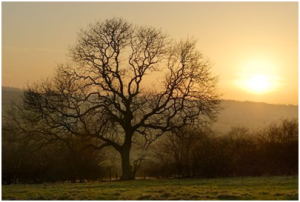
The Winter Tree
(1) The context: In our modern, secular world the Christian faith is in crisis. Since the 18th century, science and many other disciplines have challenged or rejected traditional ideas of God. In addition, modern democracy gives people greater freedom to govern themselves – and to make up their own minds about their faith.
(2) Winter: Catholic Theologian Karl Rahner chose the metaphor of a ‘wintry season’ to describe faith in our modern culture. In Rahner’s metaphor of the winter tree, fruits and leaves that unfurled when Christianity was dominant have now fallen away. In this winter season, belief must get back to basics; but the preaching and teaching of the church still draws on primitive ideas of God unworthy of belief. So Rahner sought to describe a living God who provides warmth and sustenance in winter.
Crucified God of Compassion
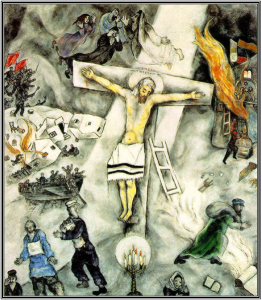
Marc Chagall – “White Crucifixion”
Note the Holocaust images in this painting: Chagall’s White Crucifixion emphasizes the suffering of Jesus and the Jewish people. The painting is startling because the crucifixion, often seen as a symbol of oppression by the Jewish people, is instead being used (by a Jewish painter) to represent their suffering. In the center is the crucified Jesus, wearing a prayer shawl as a symbol that he is Jewish. Around Jesus, Jewish people run from persecution; a synagogue is burning; a man flees carrying the Torah scroll; and at left above, the red flag of Soviet Russia communism shows that persecution of Jews was not just a Nazi phenomenon.
(1) The context – unspeakable suffering: As knowledge of the Holocaust spread, Christian theologians began to ask two questions: Why had so few Christians resisted the evils of fascism and anti-Semitism? And, where was God in all this suffering? Dietrich Bonhoeffer, eventually executed by the Nazis, had written from prison, “Only a suffering God can help.” After the war, some theologians began to say that the right question is not why a loving God allows suffering to happen, or how we can reconcile suffering with God’s governance of the world, but where is God in the midst of this suffering?
Liberating God of Life
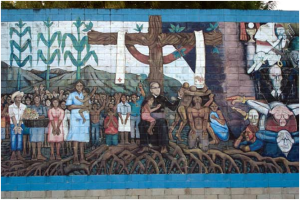
Oscar Romero Mural in San Salvador
Here the martyred Oscar Romero of El Salvador bears his bullet holes.
Romero had said, “If I am killed, I will be resurrected in my community.”
(1) The context – wretched poverty: In Latin America, decisions made by European conquerors in the 16th century – and continued by their descendants – led to widespread poverty and oppression. For centuries, Catholic Church leaders were complicit in this situation; but by the second half of the 20th century, Latin American theologians were developing Liberation Theology.
God Acting Womanish

Mosaic at Warner Memorial Presbyterian Church, Bethesda, Maryland
Jesus said, ‘How often have I desired to gather your children together,
as a hen gathers her brood under her wings… (Luke 13:34f)
(1) The context – women’s experience: Societies and religions have devalued women through human history, and this bias against women is intensified by racial and class prejudices. ¶ In society: Violence against women is common world-wide; lack of education for girls means that 2/3 of the world’s women are illiterate; and while women make up half the world’s population, they work 3/4 of the world’s working hours – but earn a tenth of the world’s salary. ¶ In the church: Despite the liberating theology of the early church, women were marginalized as the church began to organize itself – and when women are excluded from church leadership, it is commonly assumed that men have a more privileged place before God. ¶ Woman, you are set free: The women’s movement of the 1960s and 1970s led many women to work for changes in society and church. When church authorities resisted their call for change, some women left the church; others defected in place; others still remain in the church, hoping for reform.
God Who Breaks Chains
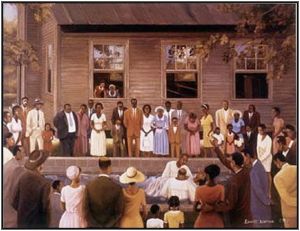
Ernest Watson – ‘In the Name of the Father’
(1) The context: This chapter looks at racism, giving a brief history of Africans in America, and their new interpretations of Christianity, expressed through African spiritual traditions. “The God who breaks chains” is at the center of Black theology.
Accompanying God of Fiesta

The Virgin of Guadalupe
In December 1531, when the peasant Juan Diego was walking in the hills outside Mexico City, he saw a vision of a lady surrounded by light. Speaking to him in Nahuatl, his own language, the lady asked that a church be built on that site. Juan Diego recognized the lady as the Virgin Mary, and told his story to the Archbishop, who told him to return to the site, and ask the lady for a sign to prove her identity. When he returned, Juan Diego saw the Virgin again, and she told him to gather flowers from the top of the hill. Although December is very late in the growing season for flowers to bloom, he found roses, which the Virgin arranged in his cloak. When he opened his cloak before the Archbishop, the flowers fell to the floor; in their place was the image of the Virgin of Guadalupe, miraculously imprinted on the fabric. The icon is now displayed in the Basilica of Our Lady of Guadalupe in Mexico City, and is Mexico’s most popular religious and cultural image.
(1) The context: la lucha (meaning, the struggle): There are several Hispanic and Latino traditions in the U.S. But in each case, the European conquest of indigenous peoples (and the later American conquest of established Latino populations) led to oppression and domination, poverty and even death. The Christian religious vision brought to the New World by the Spaniards was medieval; it was profoundly sacramental and knew nothing of the division between secular and sacred. The mixing of Spanish Mediterranean traditions and spirituality with Amerindian and African traditions (Mestizaje) yielded (positively), a gift for celebration, strong connection to family, zest for life – and (negatively) passivity to injustice and machismo (oppression of women).
Generous God of the Religions
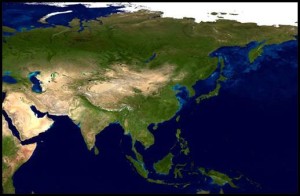
Asia from space
(1) The context: religious pluralism: In our time, religious traditions are bumping into each other as never before in history. People of all faiths are asking: How can we be faithful to our own beliefs while making space for others? Responses to this question take different paths: fundamentalists believe all other faiths are in error; relativists say it doesn’t matter which religion people choose; but other theologians in Asia have turned to inter-religious dialogue, seeking to engage different religions with critical respect.
Creator Spirit in the Evolving World

‘The blue marble ’
(photo from space)
To love the Earth: The theology of the Creator Spirit who creates, indwells, compassionately loves, and empowers the world supports an ethic of responsible care for the Earth. Therefore, the whole rich tapestry of the created order has its own intrinsic value, because it is the place where God creatively dwells. We can no longer think that morality is only for humans; if the Earth is indeed a sacrament of divine presence, then its ongoing destruction is deeply sinful desecration.